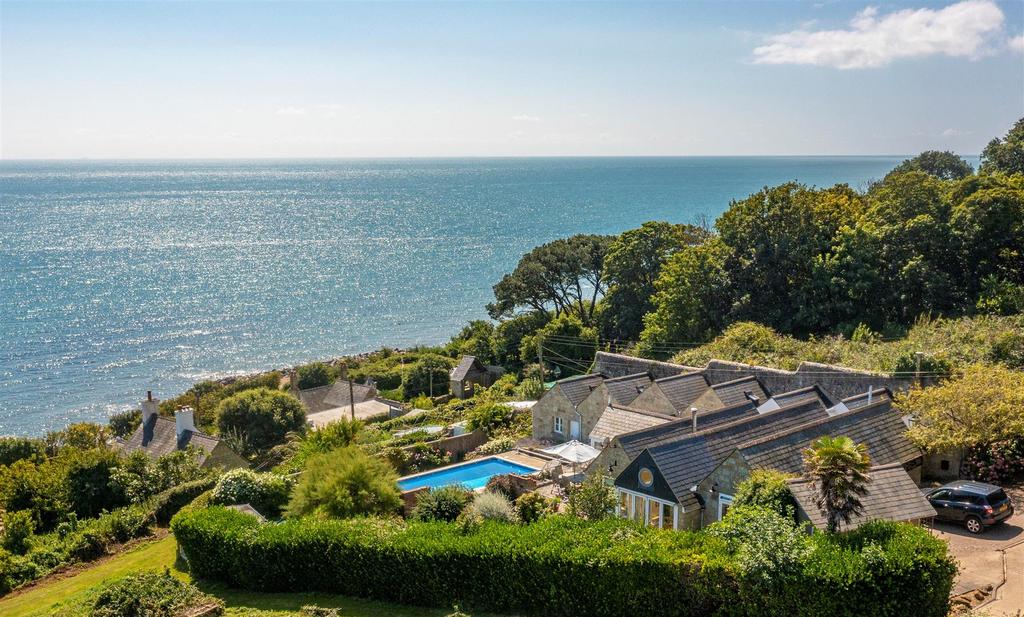Charlie Baker visits one of the Isle of Wight’s oldest villages and finds a quiet enclave of eccentricity — as well as some remarkable homes up for sale.
On Binnel Bay, a mile-long stretch of deserted beach on the southern tip of the Isle of Wight, just below the village of St Lawrence, you’ll find an unlikely monument to a German chemist. William Spindler inherited a fortune from his father and, having come to the island for health reasons, decided to develop St Lawrence as a rival resort to Ventnor, the seaside town that was then at the height of its popularity.
What Spindler possessed in wealth, he lacked in diplomacy. He printed pamphlets, which he distributed, accusing the islanders, among others things, of laziness. He planted more than a million trees and developed a seawall in Binnel Bay that has since collapsed in the clay, leaving stacks of stones in the coves that are known locally as Spindler’s Follies.
You can see why Spindler was drawn to St Lawrence: it’s England at its freshest, most verdant. It’s also England at its wildest. Eccentrics have been attracted to it for hundreds of years. The 18th century’s most famous cuckold, Sir Richard Worsley, retreated to his Marine Villa overlooking the scudding Atlantic Ocean after his estrangement from his wife.

Underley is on the same southern stretch of the Isle of Wight as Ventnor and St Lawrence. It’s for sale via Spence Willard at £1.775m.
Today, the collapse of the A3055 on the Undercliff Drive to Niton has brought a different band of hermits: on either side of the road, the properties are tended by people living off grid, tending vegetables in plots underneath the cliff, raising pigs, keeping their driveway chained up with flashing Keep Out signs.
Even at Mirables, one of the oldest estates in the area, where a 17th-century house still stands facing the sea, you can see the hulk of an old car in the gardens, its shell mingling with ferns and ivy.

Close to both St Lawrence and Ventnor, The Hermitage is a 10-bedroom Victorian home occupying a superb elevated rural position. For sale at £1.995 million via Knight Frank.
You don’t feel as if you’re in southern Britain here. The Undercliff gives a semi-tropical climate, with the temperature the warmest in the country, and vast fragmented rocks dotted around the landscape. There is a palpable sense of danger, too: roads are closed, and not reopened for years. Pathways are blocked. People keep to themselves.
For many years, St Lawrence was a smuggling hotspot; indeed, smuggling was the backbone of the Isle of Wight’s economy until the Victorians ‘discovered’ it and created a tourism boom that lasted for almost a century. But the isolation of St Lawrence still speaks to the criminal mind. In 2002, at Orchard Bay, 150 customs officers arrested five individuals who had shipped £90 million worth of cocaine from the Caribbean.
Invaders from the sea have been a constant: it is contended by local historians that on August 15, 1943, a Nazi raiding party from occupied Alderney landed at RAF St Lawrence to capture the latest radar equipment. It is said that they succeeded and that they also took a number of soldiers as prisoners. As this was the only occasion this happened on UK soil in the Second World War, it is claimed it was all hushed up by Winston Churchill, who was understandably embarrassed by the whole affair.
Today, RAF St Lawrence has been transformed into a spectacular Modernist home called The Bunker, recently on the market at £2.25 million via The Modern House.

The Bunker is on the market at £2.25 million via The Modern House. Credit: The Modern House
Up in the main village, things are more staid, with the black-painted hydrants donated by Spindler occasionally visible on the quiet roads, where bulky Victorian villas with names such as Spring Cottage are set back from the road behind thick walls.
In the heart of the village lie two churches, both well maintained on my visit. The older church is reputed to be the smallest in the country and is certainly one of the oldest in the island, dating to the 12th century, and has a beautiful garden maintained by the local community abutting the graveyard.
Might this be the place where we finally escape eccentricity in St Lawrence? Even this tiny parish church is tinged with weird England: on the roll of vicars by the door, you will see the Revd Corbert Shelberry, who was fishing for crab in Binnel Bay when a passer-by reminded him that it was the Sabbath. Hurrying into the church, he cracked his skull on the low north door and died on the spot. Shelberry, who was vicar from 1734–54, is now, fittingly, buried in a tomb in the church where he died.

Best country houses for sale this week
A house that's straight out of Cider With Rosie, and a picture-perfect cottage that's commutable to London make it into




